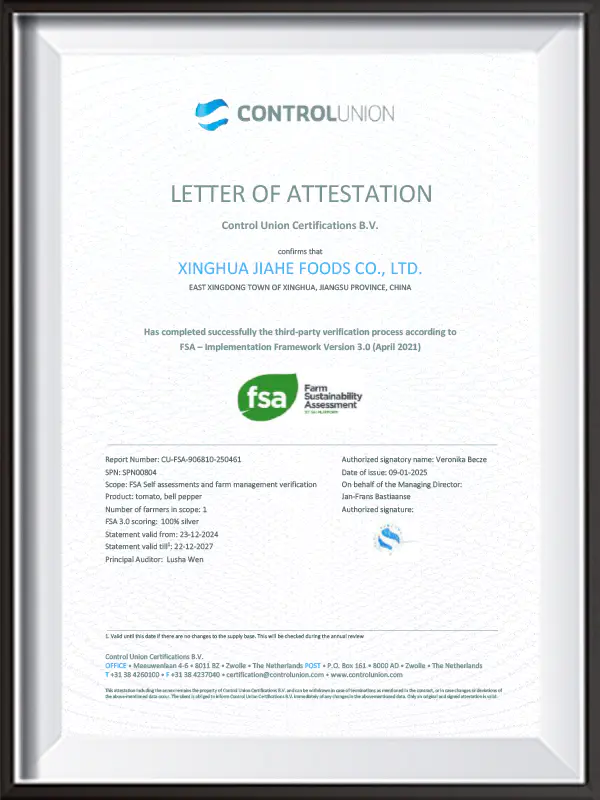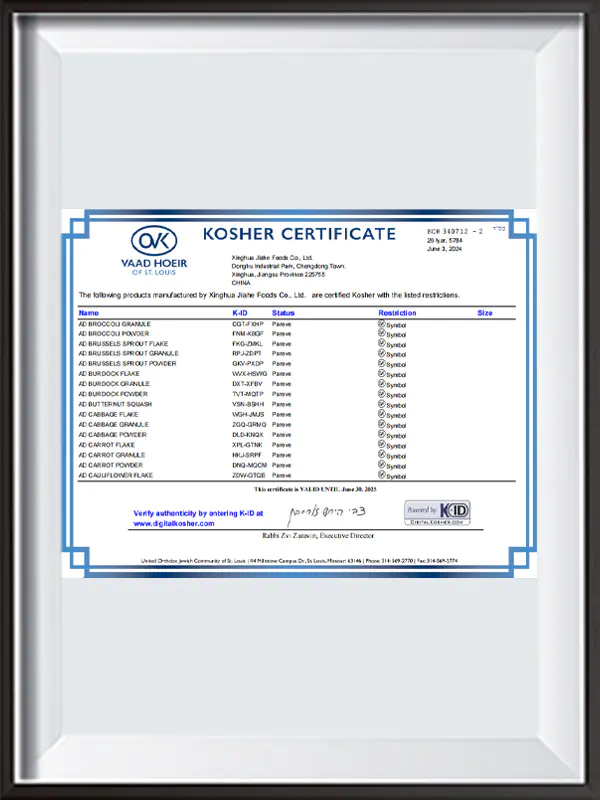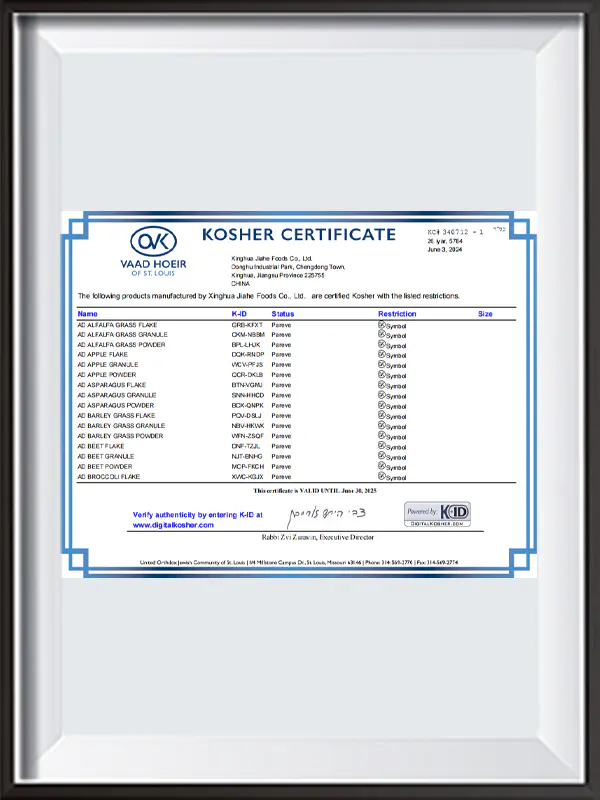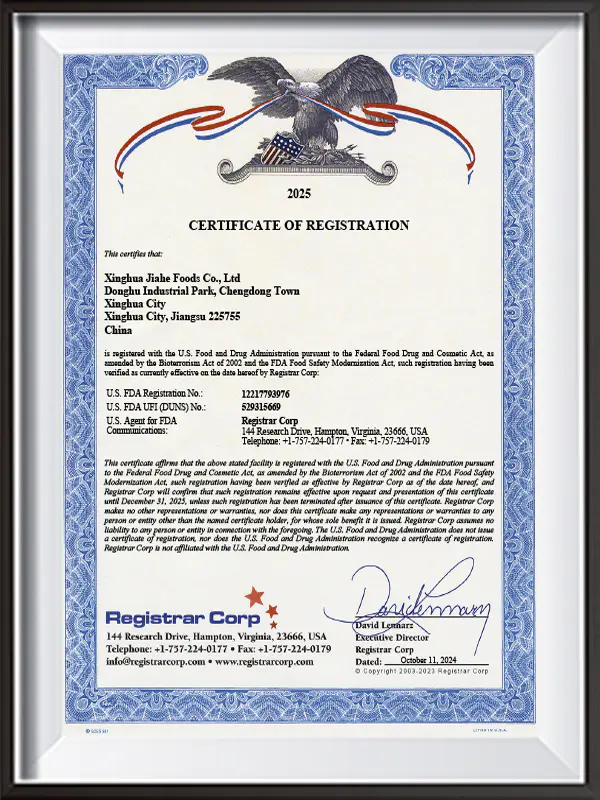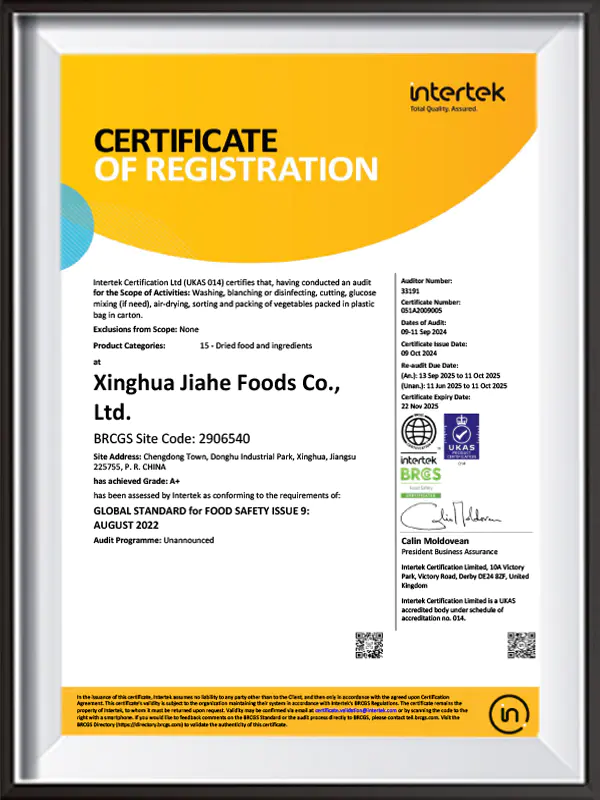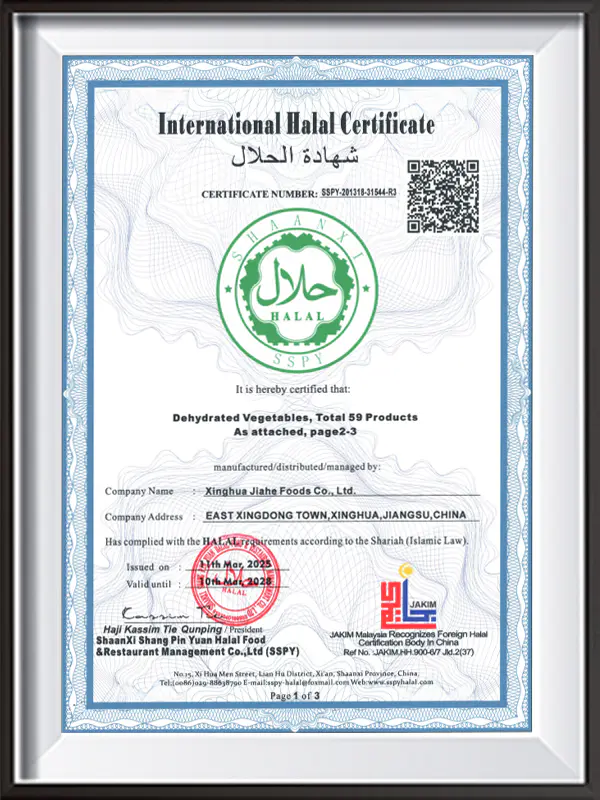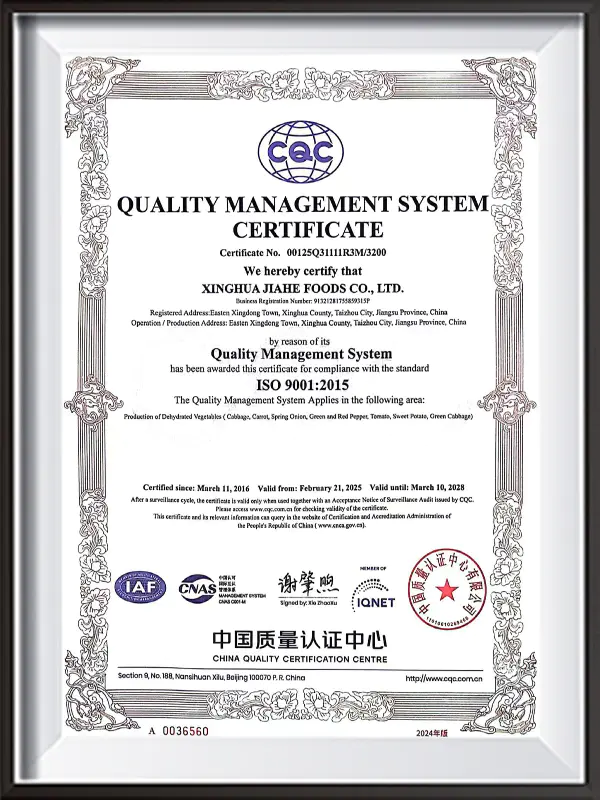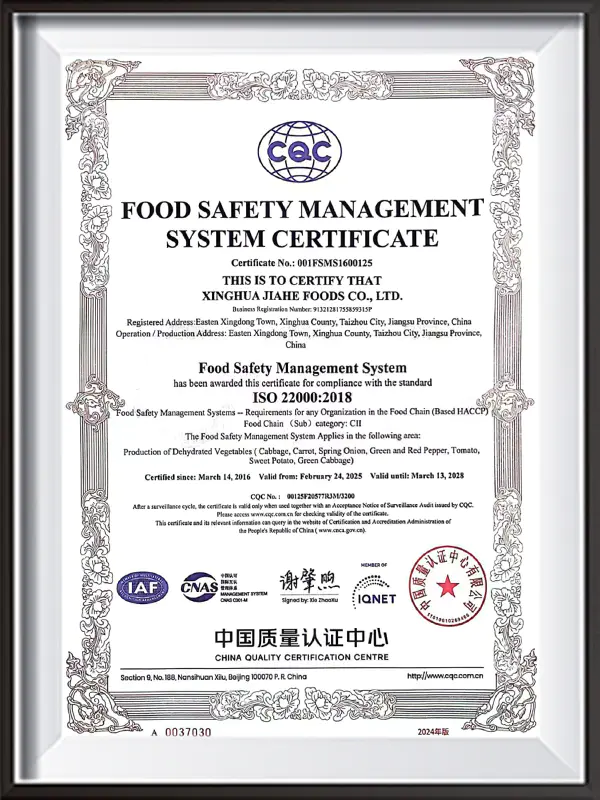Xinghua Jiahe Foods Co., Ltd is China Dehydrated Celery Manufacturers and Dehydrated Celery Factory, located in Xinghua city Jiangsu province, established in 2003. We are an experienced manufacturer and distributor of air dried vegetables and fruits in China. After more than 10 years fast development, now we are proud of being one of the top 3 manufacturers in China. We have built ourselves as a whole-range of consistent, affordable, and safe food products to the ingredient market. Our plant takes up an area of 25`000㎡with an annual capacity 8000 tons. We also have more than 300 hand-sorting workers, this is the last critical control point. Some defect materials which are out control of the facilities will be removed clearly. We have a multiple supply range. As Dehydrated Celery Exporter & Importer, we can supply you not only flake, dice, granules -- but also powder according to your need. All finish products are made from selected, fresh materials.
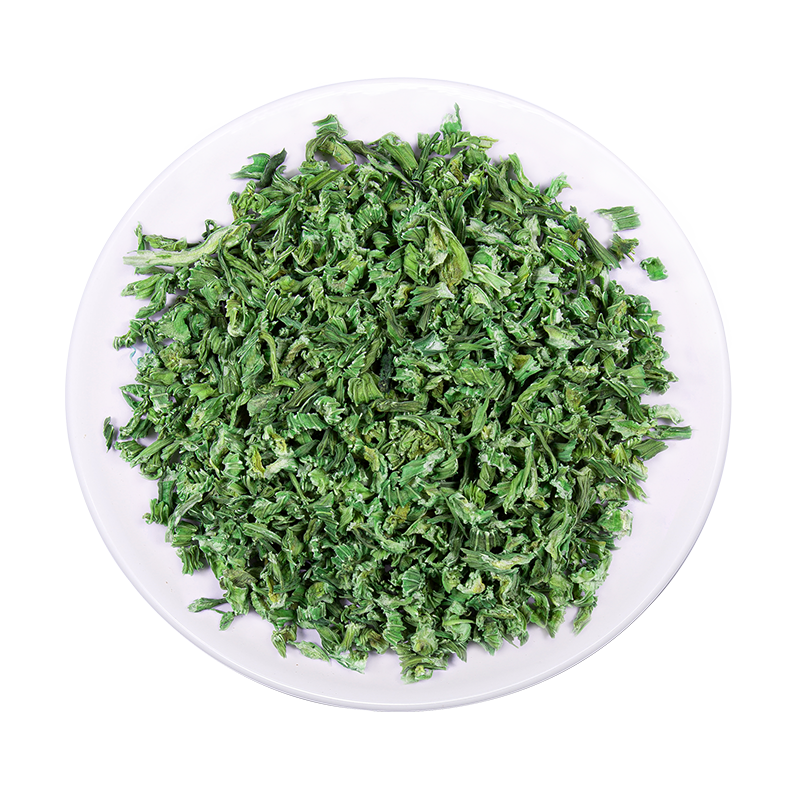
Dehydrated Celery
Field-fresh celery is sorted, washed, trimmed, blanched, and air-dried. The processing sequence initiates with rigorous cleaning protocols, material segregation, and HACCP compliance measures before proceeding to particle size modification via blade cutting or abrasive milling techniques.
- CROSS CUT
- CANNERS CUT
- CUSTOM SIZE
Dried celery as a key ingredient in instant foods, seasonings, soup bases, and ready-to-eat products. The dehydrated vegetable also functions as a healthy snack component and culinary additive for sauces, stews, and baked goods in foodservice applications.
Authentic reliable quality naturally stands out and fears no comparison.
Provide you with the latest enterprise and industry news.
-
How resistant is Dehydrated Carrot to caking or clumping under different environmental conditions?
Moisture Content, Water Activity (aw), and Hygroscopic Behavior The resistance of Dehydrated Carrot to caking is fundamentally driven by its moisture content and water activity (aw). Even though typical moisture levels range from 3–8%, Dehydrated Carrot remains mildly hygroscopic...
-
How does the moisture content of Dehydrated Sweet Potato affect its storage stability, rehydration capacity, and susceptibility to microbial growth?
Effect on Storage StabilityThe moisture content of Dehydrated Sweet Potato is one of the most critical factors determining its long-term storage stability. Low moisture levels, typically below 10–12%, reduce the water activity of the product, slowing down chemical reactions such ...
-
How does the Dehydrated Purple Sweet Potato contribute to a balanced diet, and what role can it play in supporting weight management or healthy eating habits?
1. Rich in Nutrients Dehydrated Purple Sweet Potato retains a significant portion of the nutritional value of fresh purple sweet potatoes. This makes it an excellent source of essential vitamins and minerals, particularly vitamin A, which is derived from beta-carotene. Vitamin A ...
What is dehydrated celery? Why do we need to dehydrate it?
Dehydrated celery is a kind of celery that has been specially processed to remove water. It is usually processed through steps such as washing, cutting, blanching, and drying, and finally obtains a dried celery that is easy to store, transport and use. Dehydrated celery retains the basic nutrients, taste and aroma of celery, and has a long shelf life. It is particularly suitable for food processing, ready meals, nutritional supplements and raw materials for various health foods.
The main features of dehydrated celery include:
Long shelf life: After the water is removed, dehydrated celery is not easy to rot and can be stored for a long time, which is particularly suitable for global supply chains and storage needs.
Convenient to use: In cooking, dehydrated celery can quickly restore the taste and flavor of fresh celery, reducing the waste of ingredients and saving time and labor.
High nutritional value: Although celery loses some water during the dehydration process, its rich fiber, vitamins and minerals are still retained, making it a convenient source of nutrition.
Adapt to a variety of application scenarios: Dehydrated celery is widely used in condiments, catering, fast food, convenient soups, and medicinal foods, meeting the needs of different consumers and markets.
Main application scenarios of dehydrated celery:
Ready-to-eat food: Dehydrated celery is one of the important raw materials for ready-to-eat and convenient foods. It can be mixed with other dehydrated vegetables, spices and seasonings to make various meals.
Quick-frozen food and soup: Dehydrated celery is widely used in quick-frozen food and soup because it can be quickly restored to fresh ingredients during the cooking process and retains the original aroma and flavor.
Healthy food: Dehydrated celery is rich in nutrients such as dietary fiber and vitamin C, and is an ideal choice for many healthy foods.
What is the production process of dehydrated celery?
The production process of dehydrated celery involves multiple links, from the selection of raw materials to the packaging of the final product, and each link requires strict operating standards. The following is the production process of standard dehydrated celery:
The first step in producing dehydrated celery is to select fresh celery. Celery should have a good taste and appearance, and avoid using parts that are already yellow and deteriorated. After strict screening, the celery will be washed to remove dirt, pesticide residues and other impurities attached to the surface. This process usually uses water flow washing, air flow washing or spray washing.
After washing, the celery will be further trimmed to remove parts such as roots and petioles that are not suitable for drying, and cut. According to production needs, celery can be cut into slices, segments or small pieces to adjust to a shape suitable for processing and consumption. At this time, the celery will also be sorted according to quality to ensure the uniformity and quality standards of the finished product.
In order to improve the preservation of celery and maintain its color and nutrients, dehydrated celery is usually blanched. Blanching can effectively kill bacteria, inhibit the enzyme activity in vegetables, and prevent them from darkening in color or losing nutrients during the storage process after dehydration. The blanching time and temperature need to be precisely controlled to ensure the taste and flavor of the celery.
After blanching, the celery will be further cut and adjusted in size. During the production process, the factory will use blade cutting or grinding techniques to adjust the shape and size of the celery according to market demand. This step is very critical because it directly affects the drying uniformity and final edible quality of the celery during the dehydration process.
Dehydrated celery is usually dried using air drying technology. Common drying methods include drying equipment using hot air circulation or low-temperature air drying technology. The moisture content of celery usually needs to be reduced to less than 10% to ensure its long-term preservation. During the drying process, temperature, humidity and air flow rate need to be precisely controlled to avoid over-drying or partial moisture residue, and to ensure the color, taste and nutrition of the final product.
The dried celery will be quality inspected by equipment such as magnetic detection, X-ray detection, and metal detection. These high-end equipment can accurately detect any foreign matter or unqualified products to ensure the quality and safety of the final product.
Dehydrated celery will be packaged, usually in vacuum packaging or sealed bags, to keep the product hygienic and extend its shelf life. After packaging, the product will be stored in a dry, cool environment and prepared for delivery to customers.
Dehydrated celery market trends and future development
With the increasing demand of consumers for convenient and healthy diets, the market prospects of dehydrated celery are very broad. Especially in the industries of convenience foods, seasonings, ready-to-eat meals, the application of dehydrated celery is becoming more and more extensive. The following are some important trends and future development directions of the current dehydrated celery market:
With the improvement of consumers' health awareness, low-fat, low-sugar, and high-fiber foods are becoming more and more popular. Celery, as a healthy food rich in dietary fiber and multiple vitamins, has gradually become a common ingredient on the tables of many consumers. At the same time, the market demand for organic and natural foods is also increasing. When developing dehydrated celery, manufacturers are paying more and more attention to organic planting, no additives, and natural preservation technologies.
Dehydrated celery is increasingly used in the food processing industry, especially in ready-to-eat catering, quick-frozen foods, and soups. Since dehydrated celery is easy to store and can be quickly restored, many catering brands and processing plants have begun to purchase dehydrated celery as a raw material on a large scale. In addition, many companies are exploring the mixing of dehydrated celery with other dehydrated vegetables, spices and other ingredients to launch new ready-to-eat dishes and healthy foods.
With the advancement of production technology, the production process of dehydrated celery is gradually moving towards automation and intelligence. Modern factories use artificial intelligence (AI), the Internet of Things (IoT) and big data technologies to optimize production processes, improve production efficiency, and ensure the stable quality of each batch of products. Companies invest in efficient and accurate testing equipment, such as AI color sorters, metal detectors, etc., to ensure that dehydrated celery products meet high quality standards at every stage of the production process.


 English
English Français
Français Español
Español
